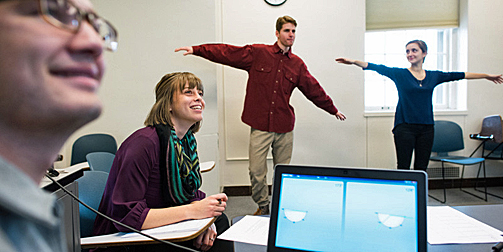Working the angles…with Kinect
Angles are all around us: the hands of a clock, the blades of a pair of scissors, the corner of a countertop. But while angles are ubiquitous in our environment, acquiring an abstract understanding of angles and their measurement, which is critical to our ability to solve geometric and trigonomic problems, is challenging for many youngsters. Happily, recent research using a Kinect sensor shows promise in helping elementary-school students rise to this challenge.

Carmen Petrick Smith, assistant professor of mathematics education at the University of Vermont (center),
works with undergraduate education majors (left to right) Tegan Garon, Sam Scrivani, and Kiersten Barr
on movements that are used to help elementary school children learn geometry.
(Credit: Andy Duback; used by permission)
Professor Carmen Petrick Smith at the University of Vermont and Professor Barbara King at Florida International University exposed 20 third- and fourth-grade students to a Kinect-enabled learning experience designed to help the youngsters discover key properties of angles by moving their own bodies. The students’ understanding of angles was measured by a test administered prior to the Kinect experience. With that baseline data in place, the students positioned themselves in front of the Kinect sensor and made various angles with their arms.
The Kinect sensor captured image and depth data about the students' arm positions, using the data to create an onscreen graphic representation in which arrows duplicated the angle formed by a student’s arms. In addition, the program turned the monitor screen one of four colors, depending on whether the student’s arms formed an acute, right, obtuse, or straight angle. Next, the experience changed the lengths of the arrows in the graphic representation and added a virtual protractor that measured the angle in the graphic display. These visual cues helped students see that the degree of an angle is not dependent on the length of its “arms” (a common misconception among young pupils). Moreover, the addition of the protractor also helped the students acquire a sense of how angles are measured in degrees.
Following the Kinect experience, the students were again tested on their understanding of angles. Overall, students showed a statistically significant improvement after the angle activity. The Kinect program logged information about the students’ arm movements at a rate of 30 frames per second, resulting in an average of 6,619.6 recorded frames per student. This copious detailed data was crucial in analyzing the students’ learning and how their comprehension was (or in some cases, wasn’t) aided by the body movements.
The idea that body movements can enhance cognitive understanding has been established in a number of experiments, and this study provides further evidence of the value of incorporating kinesthetic learning in the curriculum. We’re delighted to see yet another example of how the Kinect sensor can be a valuable educational tool.
The Kinect for Windows Team
Key links